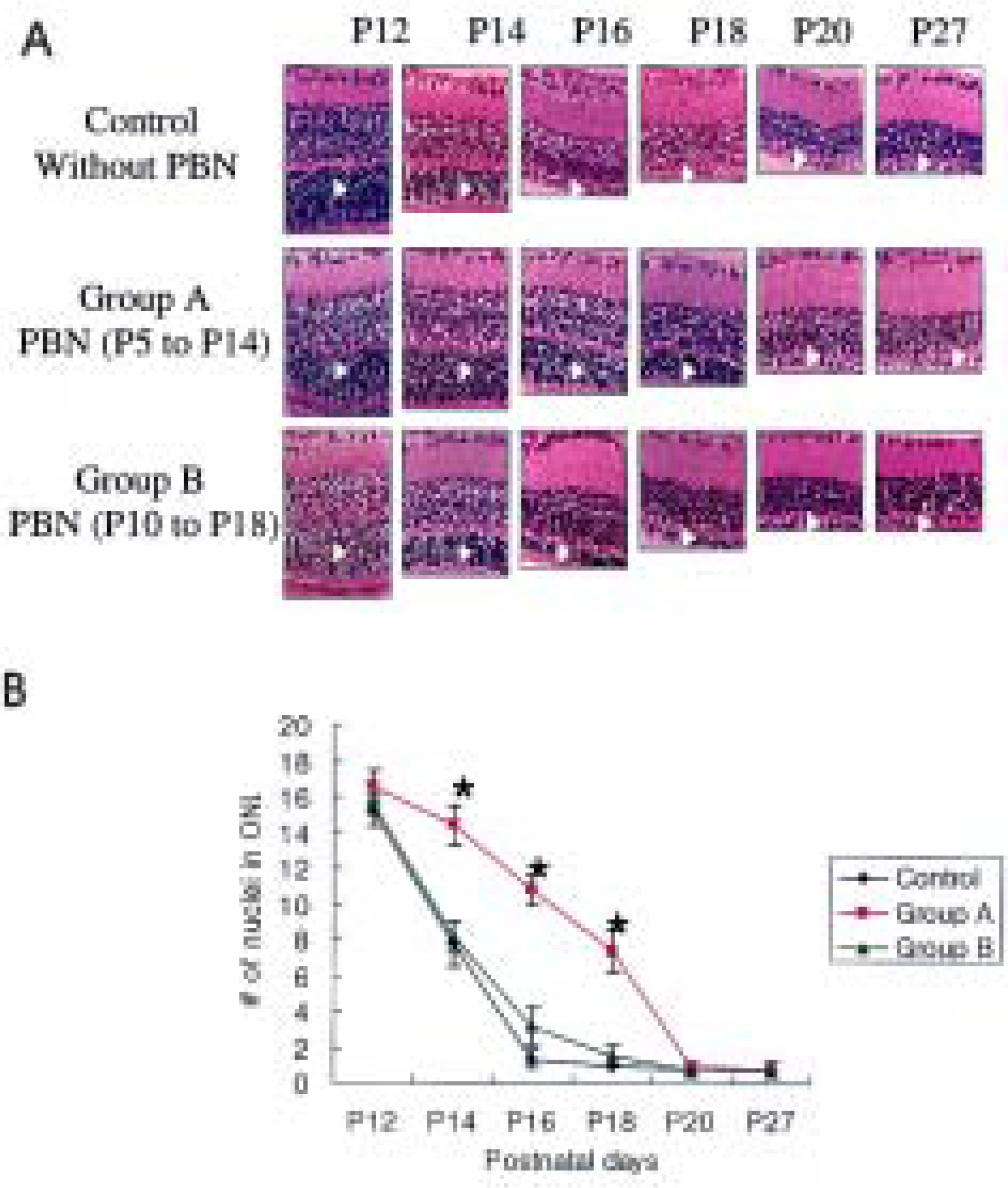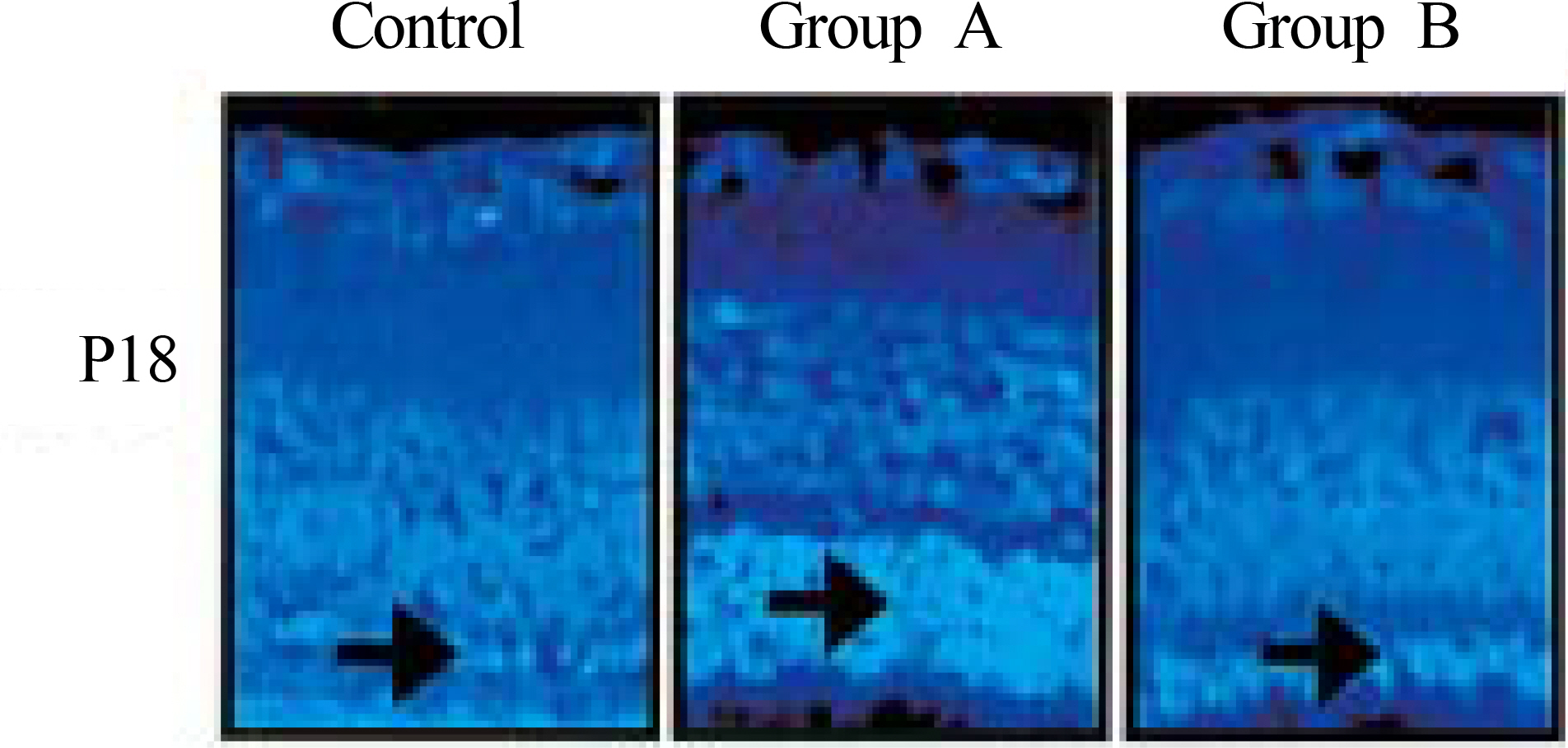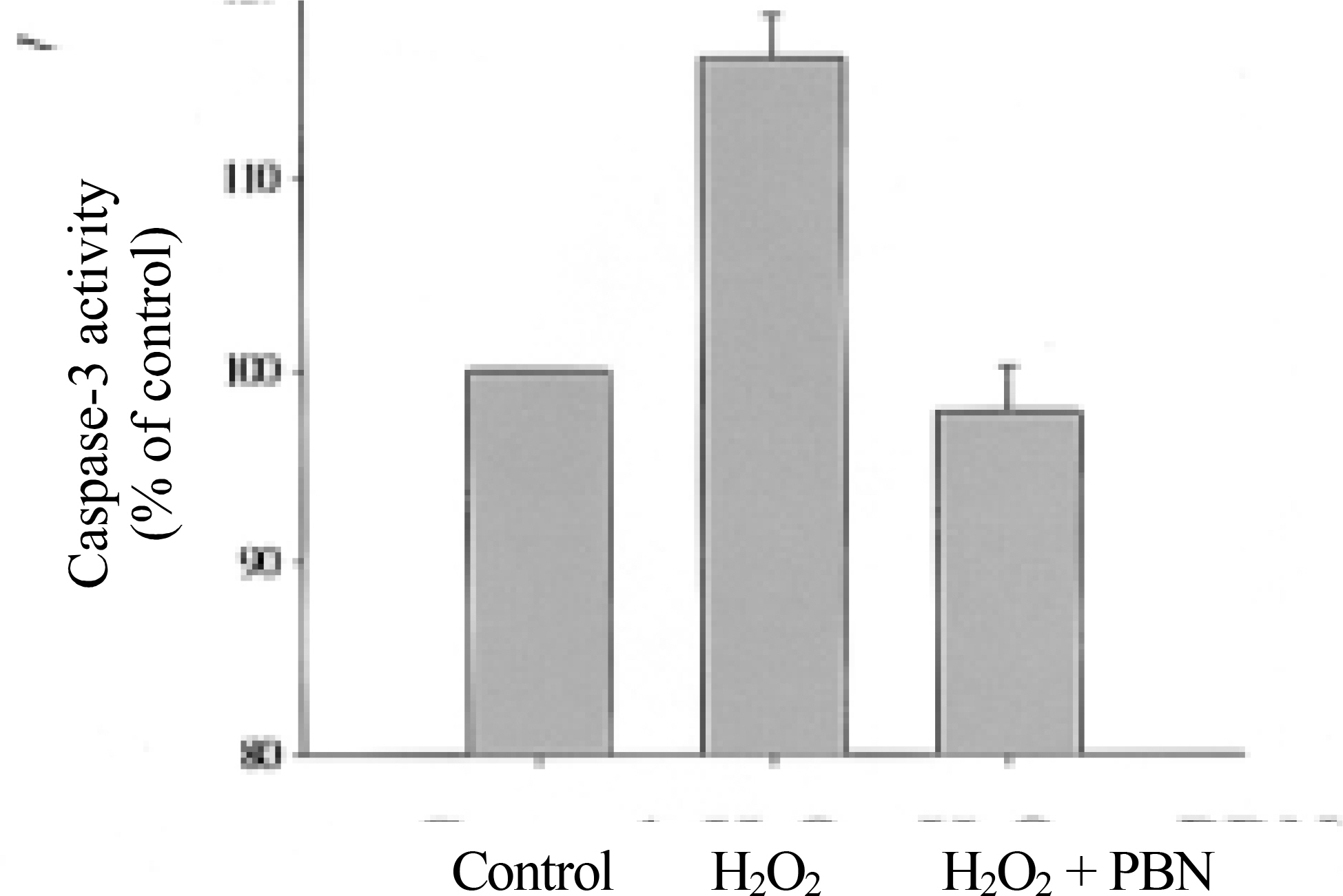Korean J Ophthalmol.
2005 Dec;19(4):288-292. 10.3341/kjo.2005.19.4.288.
Delay of Photoreceptor Cell Degeneration in rd Mice by Systemically Administered Phenyl-N-tert-butylnitrone
- Affiliations
-
- 1Department of Ophthalmology, Seoul National University College of Medicine, Seoul Artificial Eye Center and Clinical Research Institute, Seoul National University Hospital, Seoul, Korea. ysyu@snu.ac.kr
- 2Research Institute of Pharmaceutical Sciences, College of Pharmacy, Seoul National University, Seoul, Korea.
- KMID: 754441
- DOI: http://doi.org/10.3341/kjo.2005.19.4.288
Abstract
- PURPOSE
To study the effect of systemic administration of phenyl-N-tert-butylnitrone (PBN) on the degeneration of photoreceptor cells in rd mice. METHODS: PBN was injected intraperitoneally into FVB/rd mice on postnatal days (P) 5 to 14 (group A), and P10 to 18 (group B). At days P14, 16, 18, 20 and 27, morphological changes and apoptosis were analyzed by staining with hematoxylin and eosin or DAPI. The effect of PBN on apoptosis was analyzed in retinal pigment epithelial (RPE) cells by the measurement of caspase-3 activity. RESULTS: In control and group B mice, the outer nuclear layer (ONL) of the retina was composed of 8-10 rows at P12, and rapidly decreased to one row at P18. In group A mice, the ONL was preserved with 5-7 rows at P18, and decreased to one row at P22. PBN inhibited caspase-3 activity in cultured RPE cells. CONCLUSIONS: PBN delayed, but did not block, the degeneration of photoreceptor cells in rd mice. PBN may exert its inhibitory effect during the early phase of photoreceptor cell degeneration.
MeSH Terms
-
Retinal Degeneration/*drug therapy/metabolism/pathology
Pigment Epithelium of Eye/drug effects/metabolism/pathology
Photoreceptors, Vertebrate/drug effects/metabolism/*pathology
Nitrogen Oxides/*administration & dosage/pharmacokinetics/therapeutic use
Neuroprotective Agents/*administration & dosage/pharmacokinetics/therapeutic use
Mice
Male
Injections, Intraperitoneal
Free Radical Scavengers/*administration & dosage/pharmacokinetics/therapeutic use
Follow-Up Studies
Female
Enzyme Precursors/metabolism
Disease Models, Animal
Cells, Cultured
Caspases/metabolism
Caspase 3
Apoptosis/drug effects
Animals
Figure
Reference
-
1. Weleber RG, Gregory-Evans K. Retinitis pigmentosa and allied disorders. In: Ryan, SJ ed. Retina, revised ed. Missouri: Mosby. 2001; 1:chap 11.2. Chang GQ, Hao Y, Wong F. Apotosis: Final common pathway of photoreceptor death in rd, rds, and rhodopsin mutant mice. Neuron. 1993; 11:595–605.3. Lolley RN, Rong H, Craft CM. Linkage of photoreceptor degeneration by apotosis with the inherited defect in phototransduction. Invest Ophthalmol Vis Sci. 1994; 35:358–62.4. Portera-Cailliau C, Sung C-H, Nathans J, Adler R. Apoptotic photoreceptor cell death in mouse models of retinitis pigmentosa. Proc Nat Acad Sci USA. 1994; 91:974–8.
Article5. Gouras P, Du J, Kjeldbye H, et al. Reconstruction of degenerate rd mouse retina by transplantation of transgenic photoreceptors. Invest Ophthalmol Vis Sci. 1992; 33:2579–86.6. Gouras P, Du J, Kjeldbye H, et al. Longterm photoreceptor transplants in dystrophic and normal mouse retina. Invest Ophthalmol Vis Sci. 1994; 35:3145–53.7. Lopez R, Gouras P, Kjeldbye H, et al. Transplanted retinal pigment epithelium modifies the retinal degeneration in the RCS rat. Invest Ophthalmol Vis Sci. 1989; 30:586–8.8. Silverman MS, Hughes SE, Valentino TL, et al. Photoreceptor transplantation: anatomic, electrophysiologic, and behavioral evidence for the functional reconstruction of retinas lacking photoreceptors. Exp Neurol. 1992; 115:87–94.
Article9. Faktorovich EG, Steinberg RH, Yasumura D, et al. Photoreceptor degeneration in inherited retinal dystrophy delayed by fibroblast growth factor. Nature. 1990; 347:83–6.10. LaVail MM, Unok K, Yasumura D, et al. Multiple growth factors, cytokines and neurotrophins rescue photoreceptors from the damaging effects of constant light. Proc Natl Acad Sci USA. 1992; 89:11249–53.
Article11. LaVail MM, Yasumura D, Matthes MT, et al. Protection of mouse photoreceptors by survival factors in retinal degenerations. Invest Ophthalmol Vis Sci. 1998; 39:592–602.12. Bennett J, Tanabe T, Sun D, et al. Photoreceptor cell rescue in retinal degeneration (rd) mice by in vivo gene therapy. Nature Med. 1996; 2:11249–53.
Article13. Cayouette M, Behn D, Sedtner M, et al. Intraocular gene transfer of ciliary neurotrophic factor prevents death and increases responsiveness of rod photoreceptors in the retinal degeneration slow mouse. J Neurosci. 1998; 18:9282–93.14. Travis GR, Groshan KR, Lloyd MB, Bok D. Complete rescue of photoreceptor dysplasia and degeneration in transgenic retinal degeneration slow (rds) mice. Neuron. 1998; 9:113–9.
Article15. Ranchon I, Gorrand J-M, Cluzel J, et al. Functional protection of photoreceptors from light-induced damage by dimethylthiourea and Ginko biloba extract. Invest Ophthalmol Vis Sci. 1999; 40:1191–9.16. Refsum S. Heredopathia atactica polyneuritiformis phytanic-acid storage disease, Refsum's disease: a biochemically well-defined disease with a specific dietary treatment. Arch Neurol. 1981; 38:605–6.17. Sugawara T, Sieving PA, Iuvone PM, Bush RA. The melatonin antagonist luzindole protects retinal photoreceptors from light damage in the rat. Invest Ophthalmol Vis Sci. 1998; 39:2458–65.18. Wen R, Cheng T, Li Y, et al. α2-adrenergic agonists induce basic fibroblast growth factor expression in photoreceptors in vivo and ameliorate light damage. J Neurosci. 1996; 16:5986–92.19. Frasson M, Sahel JA, Fabre M, et al. Retinitis pigmentosa: rod photoreceptor rescue by a calcium-channel blocker in the rd mouse. Nat Med. 1999; 5:1183–7.
Article20. Weissbrod P, Rosas DJ, Libhaber NN, Weissbrod EP. Longterm treatment with immunomodulation therapy in retinitis pigmentosa. Adv Biosci. 1987; 62:599.21. Novelli GP, Angiolini P, Tani R, et al. Phenyl-T-butylnitrone is active against traumatic shock in rats. Free Radic Res Commun. 1986; 1:321–7.
Article22. Clough-Helfman C, Phillis JW. The free radical trapping agent N-tert-butyl-α -phenylnitrone (PBN) attenuates cerebral ischaemic injury in gerbils. Free Radic Res Commun. 1990; 15:177–86.23. Endoh H, Kato N, Fujii S, et al. Spin trapping agent, phenyl N-tert-butylnitrone, reduces nitric oxide production in the rat brain during experimental meningitis. Free Radic Res. 2001; 35:583–91.24. McKechnie K, Furman BL, Parratt JR. Modification by oxygen free radical scavengers of the metabolic and cardiovascular effects of endotoxin infusion in conscious rats. Circ Shock. 1986; 19:429–39.25. Stewart CA, Hyam K, Wallis G, et al. Phenyl-N-tert-butylnitrone demonstrates broad-spectrum inhibition of apoptosis-associated gene expression in endotoxin-treated rats. Arch Biochem Biophys. 1999; 365:71–4.
Article26. Tabatabaie T, Kotake Y, Wallis G, et al. Spin trapping agent phenyl N-tert-butylnitrone protects against the onset of drug-induced insulin-dependent diabetes mellitus. FEBS Lett. 1997; 407:148–52.27. Nakae D, Kotake Y, Kishida H, et al. Inhibition by phenyl N-tert-butylnitrone of early phase carcinogenesis in the livers of rats fed a choline-deficient, L-amino acid-defined diet. Cancer Res. 1998; 58:4548–51.28. Ranchon I, Chen S, Alvarez K, Anderson RE. Systemic administration of phenyl-N-tert-butylnitrone protects the retina from light damage. Invest Ophthalmol Vis Sci. 2001; 42:1375–9.29. Sen S, Phillis JW. Alpha-phenyl-tert-butylnitrone (PBN) attenuates hydroxyl radical production during ischemia-reperfusion injury of rat brain: an EPR study. Free Radic Res Commun. 1993; 19:255–65.
Article30. Pazos AJ, Green EJ, Busto R, et al. Effect of combined post-ischemic hypothermia and delayed N-tert-butyl-alpha phenylnitrone (PBN) administration on histopathological and behavioral deficits associated with transient global ischemia in rats. Brain Res. 1999; 846:186–95.31. Carter-Dawson L, LaVail MM, Sidman R. Differential effect of the rd mutation on rods and cones in the mouse retina. Invest Ophthalmol Vis Sci. 1978; 17:489–98.32. Kotake Y, Sang H, Miyajima T, Wallis GL. Inhibition of NF-kB, iNOS mRNA, COX2 mRNA, and COX catalytic activity by phenyl-N-tert-butylnitrone (PBN). Biochim Biophys Acta. 1998; 1448:77–84.33. Poyer JL, Floyd RA, McCay PB, et al. Spin-trapping of the trichloromethyl radical produced during enzymic NADPH oxidation in the presence of carbon tetrachloride or bromotrichloromethane. Biochim Biophys Acta. 1978; 539:402–9.
Article34. Sang H, Wallis GL, Stewart CA, Kotake A. Expression of cytokines and activation of transcription factors in lipopolysaccharide-administered rats and their inhibition by phenyl-N-tert-butylnitrone (PBN). Arch Biochem Biophys. 1999; 363:341–8.
Article35. Craig R, Wagner M, McCardle T, et al. The cytoprotective effects of the glycoprotein 130 receptor-coupled cytokine, cardiotrophin-1, require activation of NF-kB. J Biol Chem. 2001; 276:37621–9.36. Monti E, Supino R, Colleoni M, et al. Nitroxide TEMPOL impairs mitochondrial function and induces apoptosis in HL60 cells. J Cell Biochem. 2001; 82:271–6.
Article37. Stoian I, Oros A, Moldoveanu E. Apoptosis and free radicals. Biochem Mol Med. 1996; 59:93–7.
Article38. Torcia M, De Chiara G, Nencioni L, et al. NGF inhibits apoptosis in memory B lymphocytes via inactivation of p38 MAPK, prevention of Bcl-2 phosphorylation and cytochrome C release. J Biol Chem. 2001; 276:39027–36.39. Kim DH, Kim JA, Choi JS, Joo CK. Activation of caspase-3 during degeneration of the outer nuclear layer in the rd mouse retina. Ophthalmic Res. 2002; 34:150–7.40. Yoshizawa K, Kiuchi K, Nambu H, et al. Caspase-3 inhibitor transiently delays inherited retinal degeneration in C3H mice carrying the rd gene. Graefe's Arch Clin Exp Ophthalmol. 2002; 240:214–9.
Article41. Zhang C, Shen W, Zhang G. N-methyl-D-aspartate receptor and L-type voltage-gated Ca(++) channel antagonists suppress the release of cytochrome C and the expression of procaspase-3 in rat hippocampus after global brain ischemia. Neurosci Lett. 2002; 328:265–8.42. Kelicen P, Cantuti-Castelvetri I, Pekiner C, Paulson KE. The spin trapping agent PBN stimulates H2O2-induced Erk and Src kinase activity in human neuroblastoma cells. Neuroreport. 2002; 13:1057–61.43. Zeiss CJ, Neal J, Johnson EA. Caspase-3 in postnatal retinal development and degeneration. Invest Ophthalmol Vis Sci. 2004; 45:964–70.
Article44. Ranchon I, LaVail MM, Kotake Y, Anderson RE. Free radical trap phenyl-N-tert-butylnitrone protects against light damage but does not rescue P23H and S334ter rhodopsin transgenic rats from inherited retinal degeneration. J Neurosci. 2003; 23:6050–57.
Article
- Full Text Links
- Actions
-
Cited
- CITED
-
- Close
- Share
- Similar articles
-
- Activation of Caspase-3 During Photoreceptor Degeneration in rd Mouse Retina
- Antinociceptive effect of phenyl N-tert-butylnitrone, a free radical scavenger, on the rat formalin test
- Effect of Oxygen on Photoreceptor Degeneration in Retinal Degeneration Mice
- The effect of oxygen on retinal degeneration in wild-type and hsp70.1 knockout neonatal retinal degeneration mice
- Effect of the absence of heat shock protein 70.1 (hsp70.1) on retinal photoreceptors in normal and rd mice





